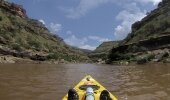Words: Dirk van den Berg | Photos: Dirk van den Berg & Hannes Cronje
Kayaking … just the sound of the word evokes thoughts of adventure; be it a leisurely paddle at your local water spot, tackling the surf at the coast, running a few bone-crunching rapids down a river or packing your touring kayak for a multi-day trip. My friend and I are kayaking enthusiasts and always on the lookout for new destinations to play in. So when the opportunity to tour around the beautiful Inhaca Island and relatively untouched Portuguese Island, in Mozambique, presented itself, we didn't hesitate.
A very relaxed five-day kayaking trip followed, in which we covered roughly 38 km, stayed in three different campsites, took in some breathtaking scenery, snorkelled the reefs, swam in warm turquoise water and sampled the legendary Tipo Tinto Rum and 2M. But I'm getting ahead of myself, so let me start at the beginning of our trip.
The Road to Maputo
We decided to go with Canoe & Kayak World, the same operator that we had purchased our kayaks from, three years ago. As we had to meet the group at Maputo Harbour at 5 a.m. on the Friday morning, we decided to overnight in Maputo on Thursday. Our trip coincided with a long weekend, and from past experience we knew the Komatiepoort border crossing would be a nightmare and that we’d be in for a fair bit of harassment from the local border 'helpers' and long queues. Not wanting to put ourselves through that, we opted to travel via Swaziland into Mozambique. It was a beautiful drive and no queues to speak of; this route is definitely advisable during peak seasons!
We arrived in Mozambique and immediately set about finding accommodation for the night. Normally one would plan this in advance, but there was a yachting competition taking place the next day and most of the hotels were fully booked. So what does one do? You 'wing it'! For my mate and I this was nothing new, as we normally just take things as they come, typical bachelor behaviour I presume. The girls, however, were a bit more worried about our prospects. We eventually found accommodation at R450 per person in an old hotel in the heart of Maputo. After checking in, we hit the streets in search of a small, vibey bar or restaurant. Four blocks from the hotel we found what we were looking for, and celebrated the end of the day with our first 2M beer.
Day 1 - Maputo to Inhaca
Up before the sun, we arrived at the harbour at 5 a.m. The right time, but wrong harbour. Some friendly and utterly amused fishermen directed us towards the correct harbour, where we eventually joined the rest of our group. We packed our kayaks, closed the hatches and carried the kayaks to the bow of the motorised catamaran, where a total of 25 kayaks were stacked closely together on the bow. It was a perfect day as we left Maputo on a two-and-a-half-hour cruise towards the beautiful island of Inhaca.
Arriving at Inhaca, the catamaran dropped anchor roughly 200 m from the shore in what was arguably a rough sea when considering what we were about to do. One by one we got into the kayaks, closed the spray deck, and were lowered into the sea. The trick was to get going as quickly as possible, so that your forward momentum gave you the necessary stability to stay upright when the waves hit you. Paddling to shore, we regrouped on the soft, sandy beach for lunch. Once satiated, we returned to the water for a 9km paddle along the bay of Inhaca. This quickly turned into a tough two-hour journey, as the wind had turned against us and we had to fight against a strong current. If you stopped paddling for just a few seconds you were literally pushed backwards. None the less, the incredible scenery soon made us forget about the rough paddling conditions and before long we arrived at Ponte Torres. As the sun started to dip, we quickly set up camp at what would be our home for the next two nights.
Day 2 - Ponte Torres
We woke up in paradise! That is if you prefer to be in nature and don't mind only having access to basic amenities, as there is no star-rated accommodation here. If you want fresh water, you filter and boil it. And if you are looking for a toilet, well you arm yourself with a shovel and look for a private, vegetated area, preferably one with a view of the ocean J.
There was nothing planned for the day so we could do as we pleased, which entailed indulging in the many activities that were available to us. The only limitation was your imagination. After breakfast we decided to go snorkelling and explore a nearby reef. The visibility was brilliant, 12 m plus! With no surge we were easily able to navigate the reef without fear of being slammed into the sharp edges of the rocks. This vibrant reef is elongated and stretches along the side of the beach, and with a gentle current to help us along, no finning was required. We proceeded to spend the next few hours happily exploring the many nooks and crannies of this magical underwater world, which was alive with an abundance of fish of every colour imaginable.
After our snorkel it was time for a nap, and if you had a hammock so much the better. Note to self: I definitely need to get a hammock! Later we visited the small village on the other side of the island, which we reached by bush taxi; if a Toyota Land Cruiser could be considered a taxi. We soon realised why a 4 x 4 was necessary as we crossed roughly 15 km of winding sand roads, with some areas merely a tunnel through the dense island vegetation and barely big enough for the Cruiser to fit through. It was like a bush-island rollercoaster ride! The village is fairly elementary, with just a few informal shops and three bars, but you can get whatever you need there. Just don’t expect to see South African brand names on the shelves though.
To end the day off we went for a night snorkel. A diving torch illuminated the reef and we saw entirely different species to what we had seen earlier in the day. There were massive hermit crabs, lobsters and lionfish. The highlight, however, was the bioluminescent algae that glowed in bright, neon green colours when disturbed. Needless to say we splashed in the water like little children enjoying this amazing phenomenon. Later I Googled this marine wonder and found the following explanation: “Microscopic organisms known as dinoflagellates cause this eerie event. When disturbed, each individual gives off a brief flash of light.” For a full explanation visit:
www.dtmag.com/Stories/Ocean%20Science/01-98-ecoseas.htm
Day 3 - Marine Station
Leaving early on the third day, we embarked on a 12 km paddle across the bay and along the beach towards our second campsite, the Marine Station on Inhaca Island. This site offered more luxurious facilities, such as proper toilets and hot showers. As you pass the active station and follow the forgotten pathways overgrown by vegetation, you come to an abandoned section of the old Marine Station. It has a haunted feeling to it, very similar to the TV series LOST, and although eerie it was a rather unique experience. After setting up camp, we took a leisurely 4 km stroll along the beach towards the village for lunch. However, walking back after lunch and a 2M or two was not exactly a popular choice, so we paid one of the local fishermen to take us back to our campsite by boat. That evening the stars shone exceptionally bright and reflected beautifully of the calm ocean; it was a perfect ending to a perfect day.
Day 4 - Portuguese Island
The paddle from Inhaca Island to Portuguese Island was a different animal all together. We were no longer paddling alongside the relative safety of an island, but rather 12 km out to sea to get from one island to the other. It was a somewhat daunting thought at first, but luckily the conditions were ideal and so the paddle turned out to be quite relaxed.
We entered Portuguese Island through a long and winding stream that snaked its way between the island and a set of dunes, and ended in a magnificent lagoon. The island itself is truly untouched, and this is what makes it so beautiful. The island is small enough to walk around, so while the women went for a walk, the men snorkelled. Knowing that this was our last night, the mood was sombre as everyone soaked in every last bit of paradise and watched a magnificent sunset over the lagoon.
Day 5 - Time to go home
A five-day trip is ideal … or so we came to agree on. But it was still with a heavy heart that I packed my kayak and joined the group, to make our way to the other side of the island and where a 60-foot catamaran awaited. We travelled back to Maputo, loaded the kayaks on the cars and said goodbye to Maputo, leaving once again via Swaziland.
Overall, the trip was well priced, balanced and we had an excellent guide. It’s a kayaking adventure I would highly recommend undertaking!
Quick facts:
Tour type: Guided, self-catering, own camping equipment (all to go on the kayaks)
Water type: Generally calm sea that’s protected by Maputo Bay
Campsites: Rustic, with no proper facilities, dig a hole, fresh water well and camp guards
Paddling distance: 38 km in total
Paddler profile: Singles, couples and families
Experience: First time paddlers to experienced paddlers
Age group: Five years and upwards
Fitness levels: Moderate fitness, able to swim and comfortable in water
Min / max paddlers: 16 minimum to 25 maximum
Closest town: Maputo, Mozambique
Of interest: Snorkelling, fishing, marine biology station and village tour
Tour availability: April through to September
Price: R2 990 per paddler and this includes all paddling equipment (kayaks, spray decks, paddles and pfds), experienced guide, ferry, campsites fees, island levies and snorkelling fees
Price: R2 490 per paddler, with your own kayak from Canoe & Kayak World
For more information about the kayak tours on offer, contact Canoe & Kayak World at www.canoekayak.co.za or www.kayaktours.co.za




